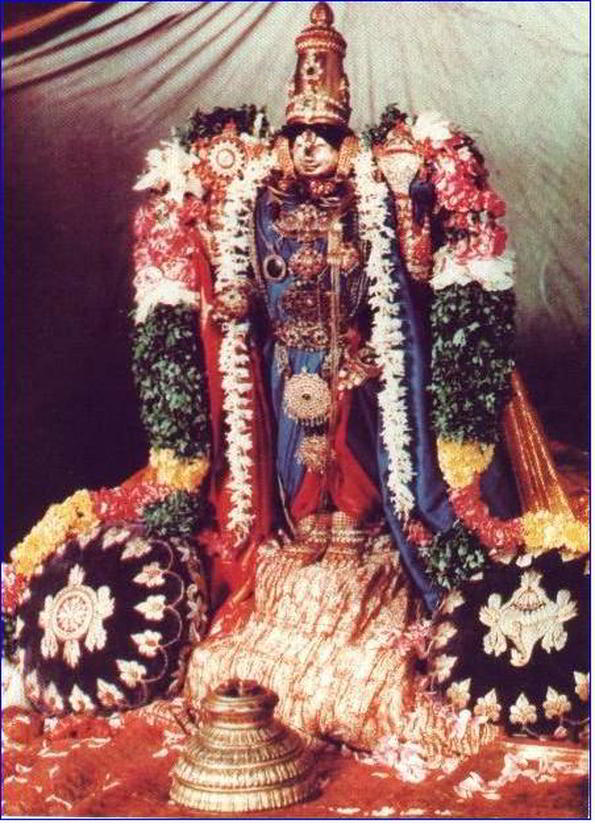- SlOkam 7:
- SlOkam 8:
- SlOkam 9:
yadeeya-SikharAgatAm SaSikalAm tu SaakhAmrugA:
nireekshya haraSekharee-bhavanam aamrusanta: tata: |
spruSanti na hi devatAntara samASriteti sphuTam
sa yEsha sumAhA-taru-vrajagiri gruham SrIpatE: ||
Meaning:
There are many Monkeys (SaakhA mrugA:) on the hills surrounding the divya dEsam. They are ParamaikAnthis (MaRanthum puRam thozhaar) and will not think of worshipping anyone but Srimann NaarAyaNan in His archA form at ThirumAlirum chOlai.
The ParamikAnthi monkeys see the Chandran on the third day of Sukla Paksham or KrishNa paksham as a crescent Moon and stay away from that form of Chandran since that adorns Siva’s head due to Daksha Prajaapathi’s curse. The monkeys are on top of the hill and can almost touch the crescent Moon with their hands but they refuse to do so because of the Moon’s sambhandham with DevathAntharam. They cannot do so because of their ParamaikAnthithvam.
Commentary:
The Moon during the third day of growth or waning is adjacent to the tall peaks of the mountain and it is seen very close to them by the monkeys as they sit on top of those peaks (yadeeya Sikhara aagathAm SaSikalAm nireekshya SaakhA mrughA:). They reflect on the third day crescent Moon (aamrusanta: SaSikalAm SaakhA mruga:). The monkeys decide not to extend their hands to touch the Moon because of its dEvathAnthara sambhandham of being adorned by Lord SivA in His Jadai to give Him the name of Chandra Sekharan (SaSikalAm nireekshya, haraSekharee bhavanam aamrusanta: SaakhA mrugA:). They do not touch therefore the Moon unlike the Devasthrees in the previous slOkam. This is clear (sphuTam). Such is the glory of this VrushAdhri, the permanent residence of SundararAjan because of the presence of ParamaikAnthis every where. Only the Moon crescent of the third day has the dEvathAnthar dhOsham, not the full Moon or ashtami chandran et al. The monkeys refuse to have contact with that particular Moon crescent.
sundaradOr-divyAj~nA lambhanakaatara-
vaSaa-anuyAyini kareeNi |
praNayaja-kalaha samAdhi :
yatra vanAdri sa yEsha sundaradOshNa: ||
Meaning:
The male and female elephant couple roaming the VrushAdhri Mountain, the abode of the Lord, some times develops OOdal (anger from differences of opinion) and separate from each other. The male elephant cannot take the separation and cries out to its partner that it is the Lord’s command for them to stay united and the female elephant heeds that command and forgets its anger to rejoin her partner. Swamy KurEsar invokes this picture of reunion of the elephant couple in this slOkam as visualized earlier by PeriyAzhwAr in His ThirumAlirumchOlai Paasuram (PeriyAzhwAr Thirumozhi: 4.2.5). Such is the glory of these mountains, where the power of the Lord is evident everywhere.
Commentary:
The male elephant (kariNi) following the angry female elephant (kaatara vasaa anuyAyini) creates the end to their praNaya kalaham (love quarrel) by declaring that it is the divine command of Lord Sundararajan to be together and got reunited with the female elephant (divyAj~nA lampana praNayaja kalaha samAdhi:). Such is the greatness of the Mountain, where Lord Sundara Rajan resides. The chandas used in this slOkam is VaidhALeeyam.
sa yEsha soundaryanidhE: dhrutha-SriyO
vanAcalO nAma sudhAma yatra hi |
bhujangarAjasya kulasya gauravAt
na khaNDitA: kuNDalina: sikhaNDibhi: ||
Meaning:
On this Solai Malai’s hill (VrushAdhri), the snakes (KuNDalina:) as descendants of AdhisEshan (bhujanga raajan), are not attacked by the peacocks (SikhaNDibhi:), their natural enemies. Such a hill with the celebrated name of ThirumAlirumchOlai malai is the auspicious residence (Sudhama) of the wealth of Beauty (Soundharya nidhi, Sundara Raajan), on whose chest resides MahA Lakshmi (dhruta Sriya: = “yERu ThiruvudayAn” of ANDAL’s NaacchiyAr Thirumozhi).
Commentary::
Sthala PurANam for this divya dEsam refers to the Lord mediating to remove the traditional enmity between the Snakes and the Peacocks. Both respects the Lord’s presence here and desist from attacking each other. Both engage in Bhagavath Kaimkaryam.
Source:












